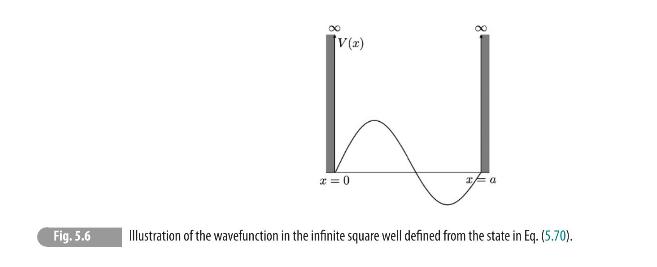Consider a particle in a quantum state (|psiangle) of the infinite square well that is a linear
Question:
Consider a particle in a quantum state \(|\psiangle\) of the infinite square well that is a linear combination of the two lowest-energy eigenstates:
\[\begin{equation*}|\psiangle \propto\left|\psi_{1}\rightangle+3\left|\psi_{2}\rightangle . \tag{5.70}\end{equation*}\]
In this problem, we will study features of this state.
(a) In the definition of the state \(|\psiangle\) presented above, I only wrote that it is proportional to this linear combination of energy eigenstates. By demanding that the state is normalized, \(\langle\psi \mid \psiangle=1\), determine the constant of proportionality to turn the relationship into an equality.
(b) In the position basis, write the wavefunction \(\psi(x)=\langle x \mid \psiangle\) for this normalized state. This is illustrated in the infinite square well in Fig. 5.6. What is the expectation value of position \(x\) on this state, \(\langle\psi|\hat{x}| \psiangle\) ?
(c) What is the expectation value of the energy or Hamiltonian \(\langle\psi|\hat{H}| \psiangle\) on this state?
(d) Now, let's assume that the state \(|\psiangle\) is the initial condition at time \(t=0\) for a state that evolves in time. Write the wavefunction at a general time \(t, \psi(x, t)\). What is the expectation value of the position on this state at a general time? What about the expectation value of the energy or Hamiltonian? Do either of these expectation values change with time?
Step by Step Answer:

Quantum Mechanics A Mathematical Introduction
ISBN: 9781009100502
1st Edition
Authors: Andrew J. Larkoski





